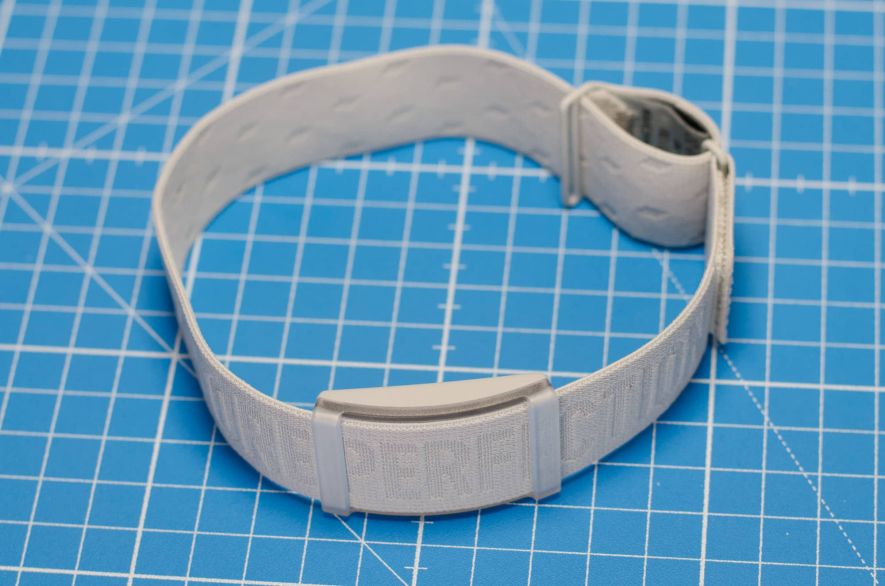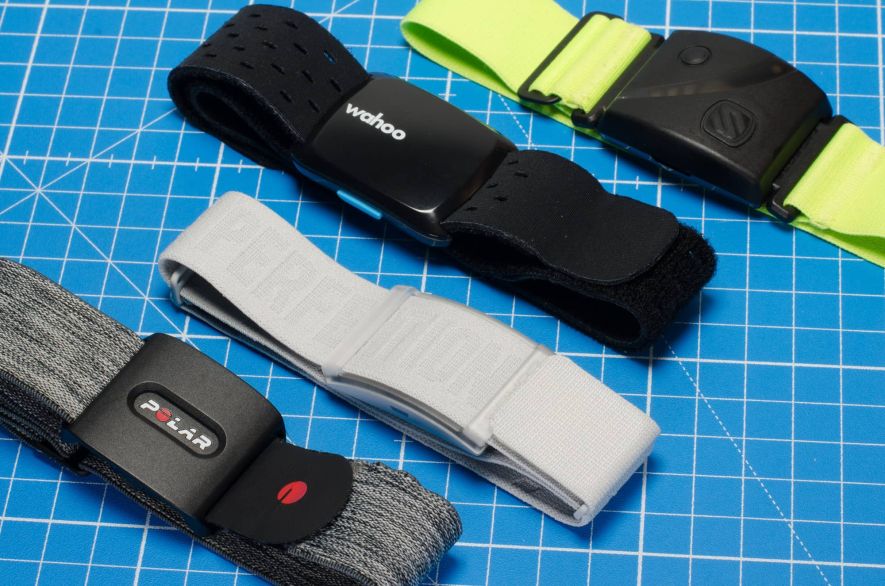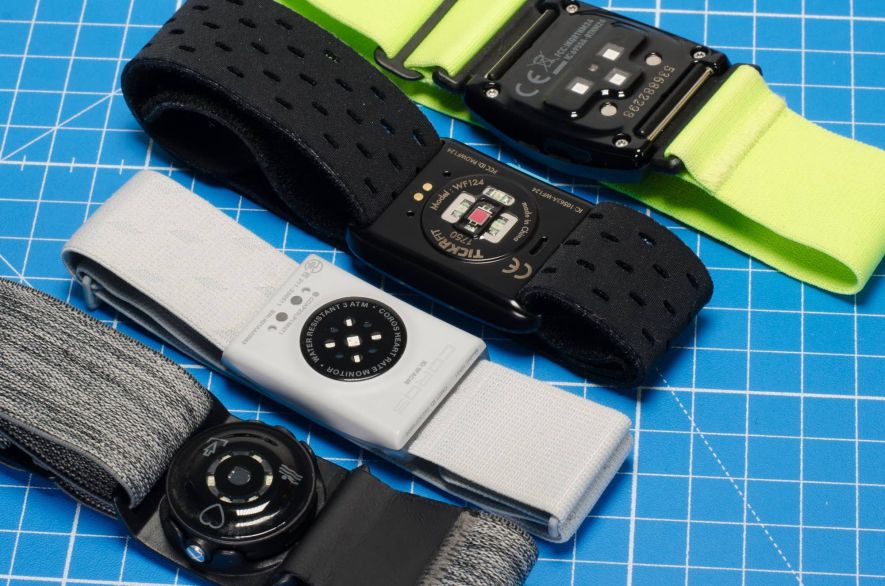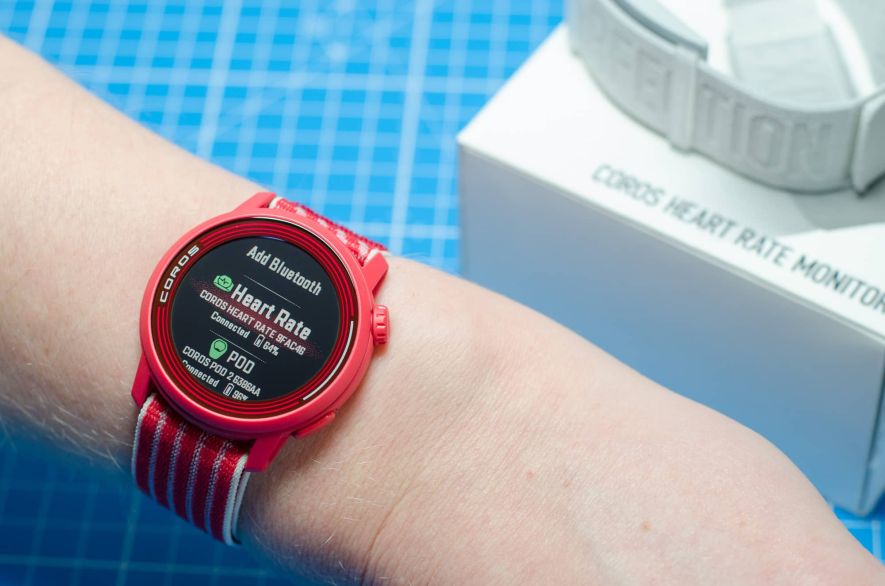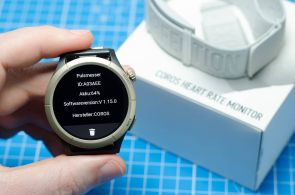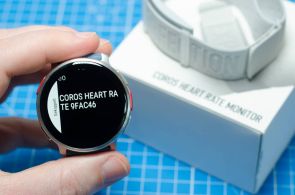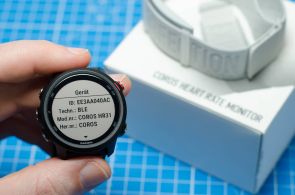Coros Heart Rate Monitor Review
Coros is well-known for its sports watches and unveiling a HR monitor for the upper arm came at a surprise. Though the kind of wearable is not entirely new, it constitutes a new product line at Coros. I had the opportunity to review the Coros Heart Rate Monitor.
Though Coros hasn’t gained as much market shares as Polar or Garmin, it is known for its sophisticated sports watches with extensive features at competitive prices. The Coros Pace 2 and now the Pace 3 are perhaps the most popular products.
With the Heart Rate Monitor, Coros introduced a new wearable in July ’23, designed to precisely measure heart rate. Since the Q4/23, the Coros HRM has also been available in Germany. A good reason to take a closer look at the product.
Unboxing and First Impression
Coros distributes the Heart Rate Monitor in a rather inconspicuous packaging, roughly the size of a Ritter Sport chocolate bar, but with a bit more depth, of course.
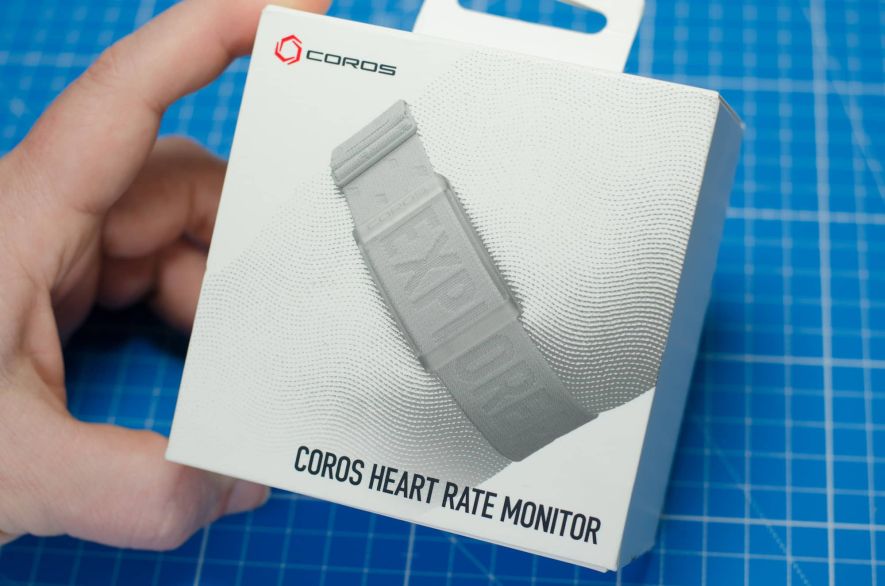
Unsurprisingly, the package contains the Heart Rate Monitor, a USB charging cable, and some paperwork.
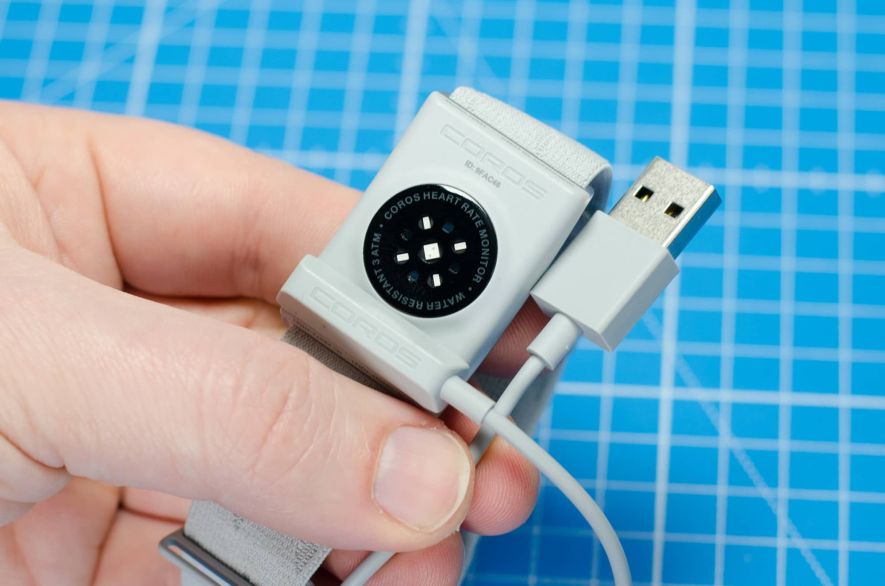
The charging cable is quite short at 25 cm, with a USB-A plug at one end and a proprietary connector with two pins at the other end. Magnets integrated into the connector ensure that the charging cable adheres to the sensor during charging. I really like the kind of plug as it easily attaches to the sensor.
When I first got my hands on the HRM, a couple of questions arose the heart because the strap hasn’t properly attached to the sensor. But let’s take it step by step…
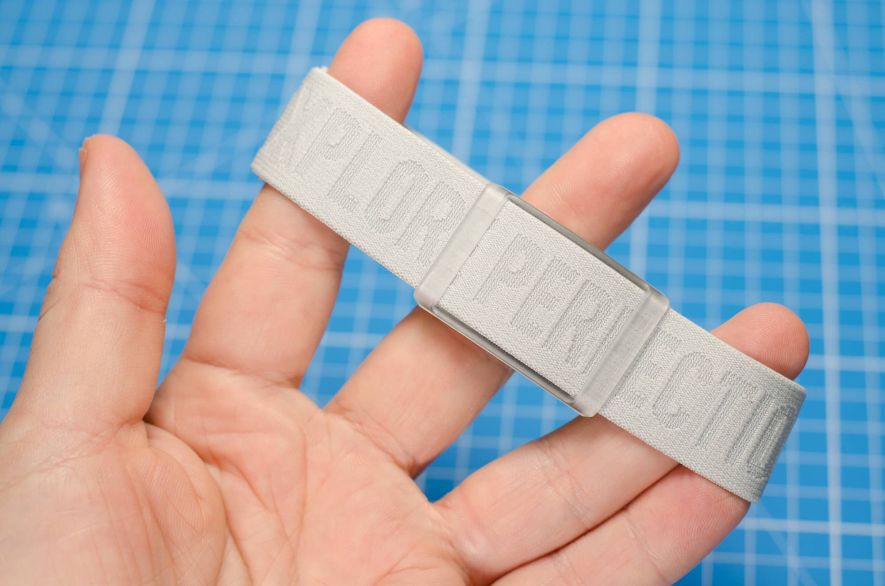
The Coros Heart Rate Monitor consists of a sensor unit and a flexible textile strap. The latter can be adjusted in width and is opened and closed using a Velcro fastener.
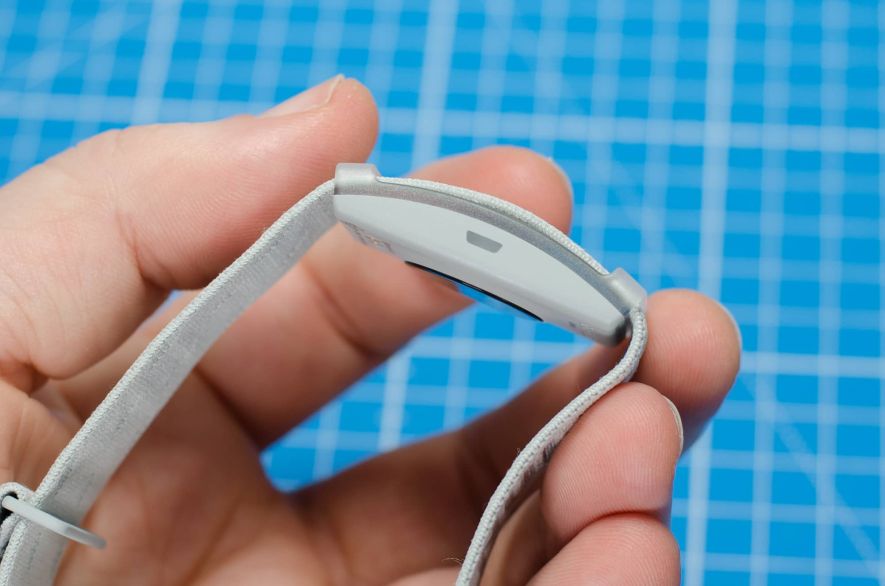
Thanks to the type of attachment, the sensor unit can be slid along the strap. But only if the Coros Heart Rate Monitor is attached as intended: When taken out of the box, it was clear right away that something was assembled incorrectly here. The inscription “Explore Perfection” was facing inward rather than outward and there was no opportunity for meaningful closure of the strap.
Not a big deal – with a little patience and the the press images at hand, I managed to set up the “correct” orientation of the strap.
In the end, this does not affect the performance of the product.
Coros Heart Rate Monitor – First steps
To start using the device, Coros couldn’t have made it any easier: The Heart Rate Monitor turns on as soon as it makes contact with the skin. As a result, Coros can omit buttons for turning the device on and off. But I’ll come back to some disadvantages of this approach.
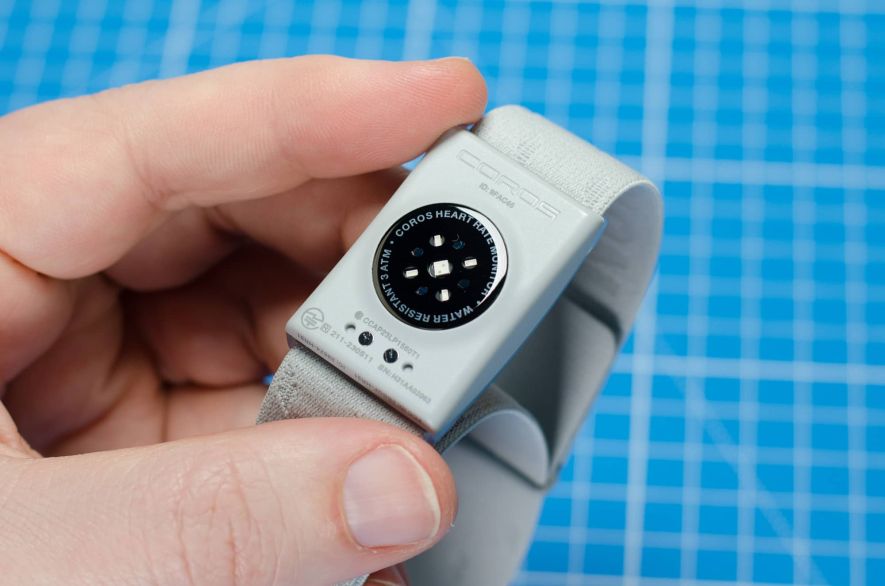
Once activated the four green LEDs on the underside of the sensor unit light up. I know it’s five LED but the one in the middle never lid up. Additionally there is a small LED on the side that indicates the battery level when the device is turned on.
If the sensor is removed from the skin, the Heart Rate Monitor goes into standby mode shortly after.
Comfort
As the strap width often adjusts, the tricky part is putting the Heart Rate Monitor on. This might be different if you use the Velcro to open and close it. For simplicity’s sake, I just slip those straps over the upper arm.
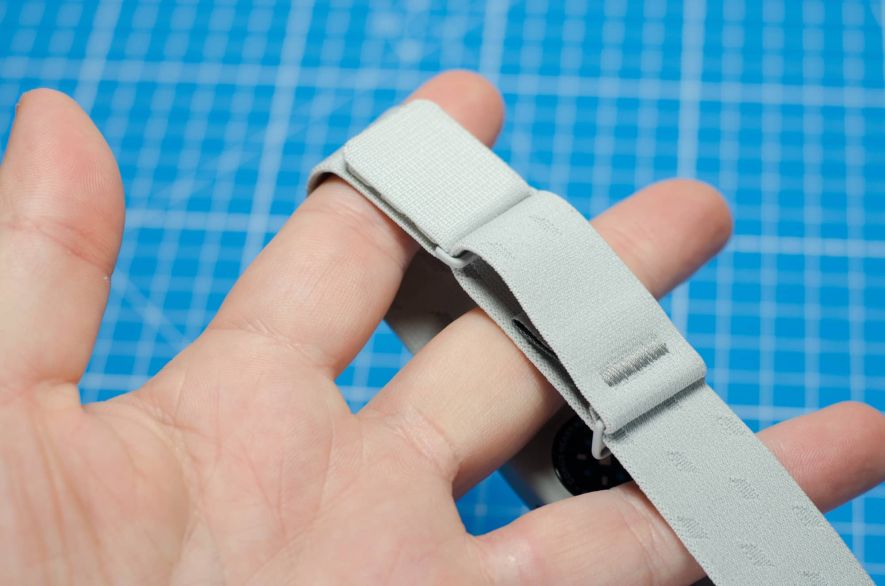
Once the strap is in place, it stays there. Even during intense physical activity – the strap neither slips nor twists.
From my experience the comfort level is extremely high. At only 19 grams, the Heart Rate Monitor is very lightweight, with the sensor unit being flat and slim. So, during exercise, you hardly notice that the Coros HRM is constantly with you.
For better comparison of size, I placed alternative products from Wahoo, Polar, and Scosche next to it:
Connection via Bluetooth LE
The Coros HRM exclusively supports Bluetooth and requires it to share its data with smartphones, tablets, or computers. Because it lacks integrated storage, the device cannot run independently.
However, the Heart Rate Monitor supports up to three simultaneous Bluetooth connections, which can be useful, for example, when heart rate data is to be used in the Swift app and on the sports watch at the same time.
It’s noteworthy that the Coros HRM can be seamlessly paired with other devices and apps. Whenever I tried to pair with a Vantage V2/V3, a Grit X Pro, or a Ignite 3 from Polar, a Forerunner 245 and a Vivoactive 4 from Garmin, or many of the watches from Amazfit and Huawei, there were no issues with any of them.
The same applies to various apps on iOS or Android: The Coros HRM is recognized without any issues.
If you own a Coros sports watch, you’ll find that after setting up the Heart Rate Monitor via the app, the sensor has already been added to the watch and only needs to be selected when needed.
Battery Life of the Coros HRM
Coros claims a battery life of up to 38 hours when the sensor is on and collecting data. In standby mode, however, the HRM lasts up to 80 days on a single charge.
I think these are realistic values, although I didn’t have to recharge during the weeks reviewing the HRM. Keep in mind that the battery charge is sufficient for more than a month with daily usage of one hour. However, there’s a small caveat: Because you can’t turn the Heart Rate Monitor off, it remains active much longer than the actual physical activity lasts.
When I go running, it takes me a while to get everything together, fulfill the last wishes of my little daughter, and finally leave the house. And even after exercising, I like to sit in the garden for about 15 minutes to cool down. During this time, the sensor is still active, even if the recording on the watch may have already stopped.
In terms of battery life, this shouldn’t be a major drawback, but it’s something to be aware of.
Accuracy in Heart Rate Measurement
Examining the HRM’s accuracy is perhaps the most interesting part of this review. To gain the most comprehensive picture possible, the Coros HRM had to compete with the following devices:
- Scosche Rhythm 24 (Test Report)
- Polar Verity Sense (Test Report)
- Wahoo TICKR Fit (Test Report)
As a reference for all optical heart rate sensors, I used the Polar H10 strap. It remains one of the best products on the market.
Let’s take a look at a few recordings, representative of pretty much all the experiences I’ve had with the Coros HRM.

It’s evident that none of the HR sensors show any weaknesses, even though it may seem like one or two devices are still settling in. By the start of the intervals, all products are on par.

If we focus on the comparison between the Coros HRM and the Polar H10 as a reference, it appears that the HR chest strap is lagging a bit behind in the recording. Experience shows that it should actually be the other way around. Perhaps the internal clocks of the Amazfit Cheetah Pro and the Garmin Forerunner 245 were not quite synchronized, as both devices were used to record heart rate data.

Looking solely at the difference between the Polar H10 and Coros HRM, there is indeed a slight time offset, but no significant deviating values.
The strong correlation between the Polar H10 and the Coros HRM is evident in the coefficient of determination of 0.968.
The Polar Verity Sense and the Scosche Rhythm 24 perform slightly better.

The accuracy during exercise on the ergometer doesn’t show any significant differences either. Here, all products are close together, if anything can be distinguished in the “curve mess” at all. Therefore, I’ve illustrated the deviations between the individual HR sensors.

Between the reference device Polar H10 and the Coros HRM, there are practically no differences. The curves are almost identical, and if there are any small deviations, they are in the correct order: the optical sensor of the Coros HRM is slightly slower than the HR chest strap.

This is also evident in the difference graph, where there is little blue area. Just as a reminder: The larger the blue areas between the two curves, the greater the differences between the two recordings.

In a direct comparison between the Coros wearable and Polar’s optical HR sensor, there is little to complain about. The minor deviations are temporary and are not significant in either ad-hoc or overall consideration.

Coros’s Heart Rate Monitor is on par with the Scosche Rhythm 24 to such an extent that I briefly wondered if I had made a mistake in the recording or assignment. But no, everything seems to be fine.

The difference from the Wahoo TICKR Fit is more pronounced.
The very good performance is evident again in the high values of R². With 0.991, the Coros HRM edges past the Polar Verity Sense. The Scosche Rhythm 24 is just a tad above with 0.998.

Another attempt and a well-known result: When running with a warm-up and a few intervals, the curves mostly align. Only during the warm-up phase, the HR sensors seem to warm up a bit themselves, and there are moments of baseline noise. Surprisingly, the Polar Verity Sense and the Scosche Rhythm 24 show two deviations during the intervals.

In a direct comparison between the HR strap and the Coros HRM, there’s nothing to complain about. The curves are almost identical, and highlighting the minimal differences would draw too much attention to discrepancies that aren’t significant.
For the first time, the Coros HRM also achieves the best value for the coefficient of determination, “following” the Polar H10’s values the best. Apart from the TICKR Fit, the other products are not far behind, and each of the strap has delivered very good performance so far.

Did I ever manage to trip up the Coros HRM in the test? Honestly, no! Even when looking for “worse” results, the competing products similarly showed some discrepancies, with most variations occurring in the first few minutes of recording.
Sometimes you can observe R² values as low as 0.95 which are still excellent.
To sum up: the Coros HRM performance is excellent, matching the Polar Verity Sense and the Scosche Rhythm 24 while outperforming the Wahoo TICKR Fit.
Coros Heart Rate Monitor - Verdict

- precise heart rate measurement
- low weight
- slim
- no onboard memory
- there are better solutions for less money
Accuracy is paramount for a heart rate sensor, and the Coros HRM excels in this regard. So far, I have not experienced any anomalies during the review – on the contrary, the Heart Rate Monitor competes on par with the established leaders, the Polar Verity Sense and the Scosche Rhythm 24, delivering essentially the same values as an HR chest strap.
Its small size and easy handling are positive aspects, disregarding the slight inconvenience of putting it on. The battery life is generous, and even with an empty battery, it can be fully charged within 2 hours.
However, the Coros HRM faces some challenges. In my opinion, this is primarily due to two factors:
Lack of Memory
Although it might seem like nitpicking, both the Verity Sense and the Rhythm 24 have integrated memory, allowing them to store HR data directly without the need for a sports watch or smartphone. This provides even more flexibility and enables their use in water activities.
Price-Performance Ratio
With a suggested retail price of €79, the Coros HRM’s price is reasonable. However, it cannot compensate for the lack of memory or the ecosystem provided by Polar. While the Polar Verity Sense has a suggested retail price of €99, it is already available in stores for around €70. The Scosche Rhythm 24 is currently available directly from the Scosche for as low as €49, although it seems to be a clearance price, and the Scosche’s app is not the best. Nevertheless, both of these options offer a more attractive price-performance ratio at the moment.
Overall, the Coros Heart Rate Monitor is still an intriguing product that won’t disappoint. If the prices in retail drop a bit more, the HRM will become even more appealing.
One more thing...
Can you imagine that this is a privately-run website? There's no office or editorial staff here, just me with a lot of passion and motivation to provide information, reviews, and news in a manner that large online magazines simply can't match. Even if English is not my first language, I hope you found this article useful.
If you'd like to support this website or show appreciation for my work, please leave a comment, share a link, or use the Amazon link to buy anything (it doesn't have to be related to the subject of this article). It would be much appreciated and will support this website.
Disclosure: The Heart Rate Monitor to me by Coros, free of charge, at my request for testing. No conditions were attached to this review, and the opinions and experiences shared here reflect my entirely unbiased assessment of the product.

